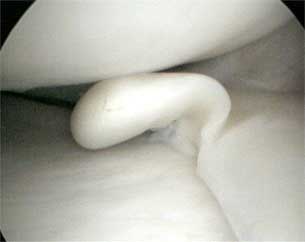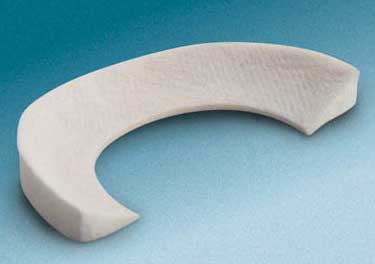The meniscal cartilages are two elastic shock absorbers that sit inside each knee between the bottom of the thigh bone (femur) and the top of the shin bone (tibia).
The medial meniscus sits in the inner side of the knee; the lateral meniscus sits in the outer side of the knee. Each meniscus is crescent shaped, looking from the top, and wedge shaped in cross section.
Meniscal tears
Tears of the meniscal cartilages are common. Tears often occur through sports injuries, such as bad tackles or falls, or awkward twisting on a bent knee. As people get older, the meniscal cartilages become worn and begin to lose their elasticity, and degenerate meniscal cartilage tears can occur with just minor trauma, or sometimes even spontaneously.

Patients may have just some, or even all of these symptoms.
The meniscal cartilages have a very poor blood supply, and therefore most meniscal cartilage tears will not actually heal up on their own. The appropriate treatment of choice is to have a knee arthroscopy (keyhole surgery).
Knee arthroscopy
Knee arthroscopy involves coming into hospital as a day case or sometimes with a 1-night stay post-operatively. A brief (about ½ hour) anaesthetic is given. Two or three small (less than 1cm) cuts are then made at the front of the knee. The knee joint is filled up with fluid and then a telescope is introduced into the knee. Attached to the end of the telescope is a tiny digital video camera. The moving images of the inside of the knee are displayed on a television screen. Probes and specially designed tiny tools and instruments can then be introduced into the knee.
Knee arthroscopy has two main roles: the first is diagnostic; the whole of the inside of the knee is examined carefully, including the knee ligaments, the meniscal cartilages and the articular cartilage (the layer of cartilage covering the surfaces of the ends of the bone). Any debris in the knee is washed out. Any loose bit of cartilage can be removed. Any rough areas of cartilage can be shaved smooth. Any torn bits of cartilage can be trimmed or repaired, as appropriate.
Via the arthroscope one can also perform:
Meniscal repair
Unfortunately, only about 15 to 25% of meniscal cartilage tears are actually surgically repairable. This percentage goes down, the longer the gap is between the injury and the actual arthroscopy. Also, these figures apply to patients under the age of 40; the older you are above this age, the less likely it is that the tissue will be repairable. Worn or degenerate meniscal tissue cannot be repaired, as it can be like trying to stitch wet tissue paper - the stitches will not hold and the tissue will not heal.
MRI scans are very poor at predicting which meniscal tears might actually be appropriate for repair vs trimming. Therefore, whether to repair or trim a cartilage is a decision that can only really be taken at the time of the operation, during the surgery. This is why the options, the pros and cons and the consequences all need to be discussed carefully pre-operatively.
If a meniscal tear is repairable, then the tissue is normally stitched back together using tiny little specialised sutures via the keyhole surgery. Occasionally it is necessary to make some additional larger incisions as well. Patients have to undergo careful restricted rehab post-operatively after meniscal repair, to protect the meniscal sutures.
The results of meniscal repair are now well-reported, with success rates in the region of 90% at 5 years. However, the true benefit of meniscal repair will really show itself in 10 or 20 years time, when we hope to see significantly reduced rates of osteoarthritis in the knee.
Meniscectomy
However, unfortunately, this still leaves a very large proportion of patients who have meniscal tears that are not suitable for surgical repair. In these patients, the tissue simply has to be trimmed back to a smooth stable rim. The short term results are good, with fairly rapid resolution of symptoms and return to activities. However, the menisci are important shock absorbers and load sharers in the knee, and loss of a meniscus increases the forces across the knee joint, increasing wear and tear. Loss of a meniscus increases the risk of developing arthritis in the knee in the future. The more meniscal tissue is lost, the bigger that risk. In most cases it will take many years for arthritis to develop in a knee and for it to cause symptoms such as pain, swelling and stiffness. However, there have been well documented cases of some patients developing quite rapid onset of severe arthritis in the knee after removal of a meniscal cartilage - particularly for the lateral (outer) meniscus, and especially in young high level athletes.
Meniscal transplantation
For these reasons, much effort has been directed towards developing ways of potentially replacing lost meniscal cartilage tissue.
If the whole meniscal cartilage has been lost, then the only real option at present is to perform meniscal allograft transplantation. This is a procedure where the missing meniscal cartilage is replaced with donor tissue, which is screened and sterilised much in the same way as other donor tissues such as for kidney transplants. The difference, however, with meniscal transplants is that the cells within the cartilage tissue are embedded in a thick and relatively impenetrable elastic tissue, which means that the patient's immune cells do not react to the new donor tissue. This means that meniscal allografts can be transplantated into patients' knees without the need for nasty immunosuppressive drugs, and with no significant risk of rejection.
The surgical procedure of meniscal transplantation has gained significant popularity in the US, with over 4000 meniscal transplants having already been performed to-date. Meniscal transplantation has been demonstrated to provide good pain relief, with success rates in excess of 80% at 5-years follow-up. Again, the real proof of this procedure will be the degree to which degenerative changes in the knee may be delayed or avoided in the long term.
Very few centres in the UK are currently offering meniscal transplantation as a surgical option, largely due to the technical and logistical complexities involved. However, the team of knee surgeons at London Sports Orthopaedics has now performed over 30 transplants, making it probably the largest centre in the UK for this kind of surgery.
The Menaflex Collagen Meniscal Implant
For those patients who have lost significant amounts of meniscal cartilage tissue, but in whom there has not been complete loss and the outer rim is still intact, there is now a new surgical option that has very recently become available to patients in the UK.
The Menaflex collagen meniscal implant is a scaffold made from collagen, which is a natural substance made of numerous fibres and bundles, and which is the major constituent of normal meniscal tissue. The implant is highly porous and acts as a scaffold, allowing a patient's cells to grow into it so that the missing meniscal tissue regrows.
The Menaflex collagen meniscal implant was invented by Kevin R Stone MD, tested and developed at The Stone Clinic in San Francisco (refs 1&2). Follow on studies were undertaken by a team including Dr Richard Steadman, from Vail, Colorado - one of the world's leading knee surgeons. The first meniscal implant procedures were performed in the US in 1993 as part of a feasibility study. The good results led to multicentre studies starting in the US and Europe in 1997. In the year 2000, the positive results in Europe led to CE certification for the medial implant, and subsequently the lateral implant also received approval and is now in clinical use. To-date, more than 1,700 patients worldwide have had collagen meniscal implants successfully inserted into their knees.
The clinical studies to date have demonstrated the following:-
- The meniscal implant is biocompatible (ie it does not cause tissue reactions and is not rejected).
- More than 70% of the patient's missing meniscal tissue regrows into the new scaffold.
- Patients receiving the meniscal implant ended up with higher activity levels compared to similar patients undergoing partial meniscectomy.
Strict adherence to an appropriate rehabilitation programme is vital after Menaflex meniscal implant surgery. Even though the discomfort from the operation is likely to subside quite quickly, after just a few days, it is still essential to protect the knee and limit activities in order to allow the meniscal implant to 'take' - ie, to allow the tissues of the knee to begin to grow into the implant from its edge (which keeps it secure in position) and for the tissue to grow into the actual scaffold, which gives the new meniscal tissue its strength. Therefore, activities need to be carefully restricted initially, with a slow supervised return to limited specific exercises under the close supervision of a physiotherapist. Vitally, patients should not return to sport until 6 months post-op.
The Menaflex collagen meniscal implant has only very recently been introduced into the UK by Hospital Innovations, a Cardiff based company. The procedure is being introduced under strict and careful guidelines. Only experienced surgeons specialising in knee surgery and who have been specifically trained in the technique are currently allowed access to the implant in the UK. It is envisaged that the results in the UK will mirror those already seen in Europe and the US. However, it has been agreed by the UK Meniscal Study Group that thorough and careful detailed clinical evaluation for all patients undergoing this surgery is essential.
References
1. Stone KR, Rodkey WG, Webber R, McKinney L, Steadman JR. Meniscal regeneration with copolymeric collagen scaffolds. In vitro and in vivo studies evaluated clinically, histologically, and biochemically. Am J Sport Med. 1992;20(2):104–111.
2. Stone KR, Adelson WS, Pelsis JR, Walgenbach AW, Turek TJ. Long-term survival of concurrent meniscus allograft transplantation and repair of the articular cartilage: A PROSPECTIVE TWO- TO 12-YEAR FOLLOW-UP REPORT. J Bone Jt Surg Br. 2010;92-B(7):941–948. doi:10.1302/0301-620x.92b7.23182.


